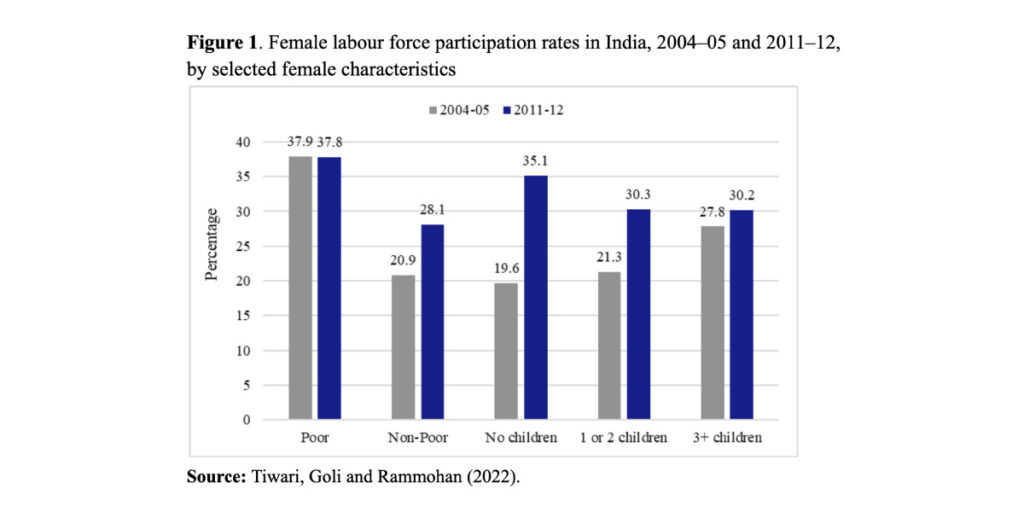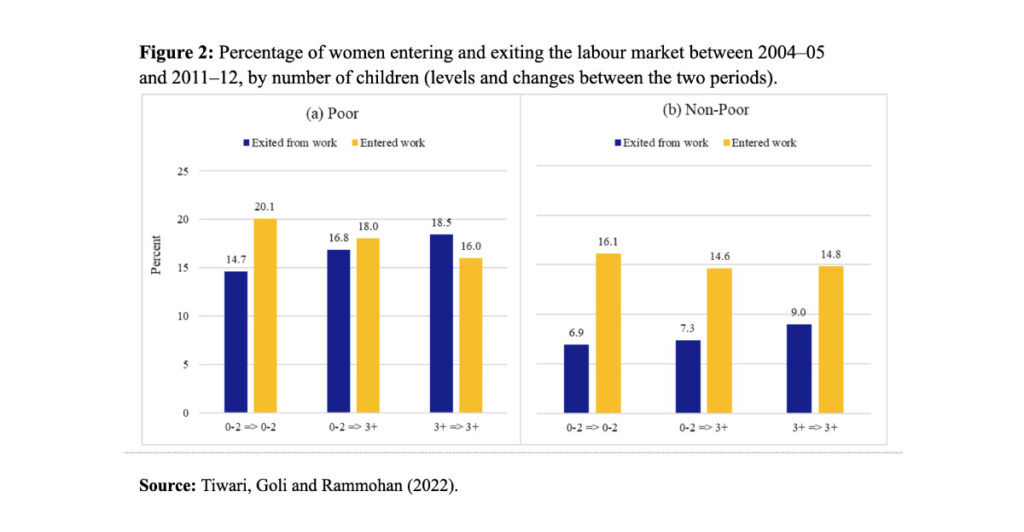Reproductive burden and women’s employment in India

Low and declining female labour force participation in India has been a puzzle and a key policy question in the recent past. Chhavi Tiwari and Srinivas Goli argue that it depends on a particularly strong motherhood penalty. India needs more effective work–family reconciliation policies if female economic activity is to be sustained.
India’s female labour-force participation (FLFP) is low and has declined over time. It was just 20% in 2019, down from 25% in 2011 and 32% in 2005 (ILO, 2022). This has negative consequences both at the individual level (e.g., for women’s autonomy and households’ wellbeing) and at the macro level, as it slows down economic growth and cancels out the potential advantages of India’s current favourable age structure (the demographic “window of opportunity”; James & Goli, 2016; Goli et al., 2021).
Lack of appropriate data has made it difficult for researchers to understand the complex dynamics of the labour market, and to solve the puzzle of the low and declining female participation. In a recent article (Tiwari, Goli and Rammohan 2022), we used a panel dataset covering seven years to better investigate the issue. We focused, in particular, on the number of children “at home”, aged 0-14 years, because caring responsibilities tend to fall disproportionately on women, in India as elsewhere (Francavilla and Giannelli, 2011).
How do children influence women’s labour force participation?
FLFP in India has traditionally been higher among the poor, because women work out of necessity to contribute to household income. Things may be changing, however, as FLFP did not increase in this group between 2004–05 and 2011–12 (Figure 1). Conversely, it increased among non-poor women by 8%, reaching 28.1% in 2011–12. Across fertility levels, FLFP increased among childless women especially, from 19.6% to 35.5%, but much less among women with three or more children.

Children’s influence on FLFP can be better understood by relating women’s transition into and out of the labour market to their fertility transition. Having, and remaining at, a small number of children leads to greater labour market participation, as shown in Figure 1, with more women entering than leaving the labour market, both among the poor and the non-poor (Figure 2).

In our scientific article (Tiwari, Goli and Rammohan 2022), we estimated the net effect of the reproductive burden on labour market participation. Each (subsequent) child reduces the probability of working, but the effect is strongest for high parities, from the third child onwards. Note that this is not merely an association: there seems to be a truly causal effect of reproductive burden on labour market outcomes.
In the same analysis, we also found that living in larger household positively affects labour market participation among women with a large progeny, because other family members (especially elder women) can take care of young children. We also found that the motherhood penalty is highest for women belonging to Scheduled Castes / Scheduled Tribes (SC/ST) and for women with no formal education.
Conclusion
In India, women’s entry into, or exit from, the labor market is sensitive to changes in the number of their offspring, which suggests the need for stronger work-family reconciliation policies. India’s 2017 Maternity (Amendment) Bill tried to address this problem, by increasing the length of paid maternity leave for working women from 12 weeks to 26 weeks. However, its effects are limited, because this provision only covers mothers who work in the formal labour market, while approximately 84% of the female labour force is in the informal sector, with no access to maternity leave provisions (Williams, 2017).
Several policies to sustain and improve women’s labour supply and reduce the motherhood penalty, are already in place. These include the Anganwadi set up under the Integrated Child Development Services programme launched in 1975, that provide free services such as basic health care and pre-school activities for children in rural areas (Maity, 2006). Such initiatives need to be expanded and extended to urban areas, where declining labor supply has been a concern among economists.
The question of paternity leaves must also be addressed, to promote gender balance in childcare responsibility. In short, India needs stronger and better “work-family” policies, to enable women to reconcile the tension between maternity/childcare and employment.
Foot note
1These are people who live in “absolute poverty” (below the so-called Tendulkar poverty line), which is based on (purchasing-power-adjusted) monthly per-capita consumption expenditure, and varies across states (Desai et al., 2010).
References
Desai, S. B., Dubey, A., Joshi, B. L., Sen, M., Shariff, A., & Vanneman, R. (2010). Human development in India. New York: Oxford University.
Francavilla, F., & Giannelli, G. C. (2011). Does family planning help the employment of women? The case of India. Journal of Asian Economics, 22(5), 412–426.
Goli, S., James, K. S., Singh, D., Srinivasan, V., Mishra, R., Rana, M. J., & Reddy, U. S. (2021). Economic returns of family planning and fertility decline in India, 1991–2061. Journal of Demographic Economics, 1–33. https://doi.org/10.1017/dem.2021.3.
International Labour Organization (ILO), ILOSTAT database. Data as of June 2022. https://data.worldbank.org/indicator/SL.TLF.CACT.FE.ZS?locations=IN
James, K. S., & Goli, S. (2016). Demographic changes in India: Is the country prepared for the challenge. Brown J. World Aff., 23, 169.
Maity, B. (2016). Interstate Differences in the Performance of” Anganwadi” Centres under ICDS.
Tiwari, C., Goli, S., & Rammohan, A. (2022). Reproductive burden and its impact on female labor market outcomes in India: Evidence from longitudinal analyses. Population Research and Policy Review, 1–37. https://doi.org/10.1007/s11113-022-09730-6.
Williams, C. C. (2017). Reclassifying economies by the degree and intensity of informalization: The implications for India. In Critical perspectives on work and employment in globalizing India (pp. 113–129). Springer, Singapore.